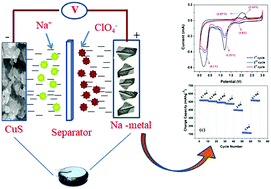当前位置:
X-MOL 学术
›
New J. Chem.
›
论文详情
Our official English website, www.x-mol.net, welcomes your
feedback! (Note: you will need to create a separate account there.)
Electrochemical studies on crystalline CuS as an electrode material for non-aqueous Na-ion capacitors
New Journal of Chemistry ( IF 2.7 ) Pub Date : 2020/03/03 , DOI: 10.1039/c9nj06465f Manoj Goswami 1, 2, 3, 4, 5 , Chandrasekaran Nithya 3, 6, 7, 8 , N. Sathish 1, 2, 3, 4, 5 , Satendra Kumar 2, 3, 4, 5, 9 , Netrapal Singh 1, 2, 3, 4, 5 , A. K. Srivastava 1, 2, 3, 4, 5 , Surender Kumar 1, 2, 3, 4, 5
New Journal of Chemistry ( IF 2.7 ) Pub Date : 2020/03/03 , DOI: 10.1039/c9nj06465f Manoj Goswami 1, 2, 3, 4, 5 , Chandrasekaran Nithya 3, 6, 7, 8 , N. Sathish 1, 2, 3, 4, 5 , Satendra Kumar 2, 3, 4, 5, 9 , Netrapal Singh 1, 2, 3, 4, 5 , A. K. Srivastava 1, 2, 3, 4, 5 , Surender Kumar 1, 2, 3, 4, 5
Affiliation

|
Current investigations are concentrated on the development of high-performance electrode materials for sodium-ion capacitors (NICs). Copper sulphide can be employed as an electrode material for sodium-ion capacitors owing to its electrical conductivity and specific capacity. Crystalline CuS provides a large surface area for Na insertion/extraction. In this context, we have reported CuS powder synthesised via a simple wet chemical route. XRD and FT-IR studies have been carried out to determine the phase formation and confirm the purity of the CuS powder. A specific surface area of 62 m2 g−1 is measured by a BET surface area analyser. NICs were assembled in a non-aqueous medium with CuS particles and investigated for charge–discharge cycling in the potential window from 0.01 to 3 V. Cyclic voltammetry (CV) confirmed that at a high scan rate from 10 mV s−1 to 100 mV s−1, the CuS particles showed ideal capacitive behaviour. The calculated value of specific capacitance was 160 F g−1 for the CuS particles. At a scan rate of 1 mV s−1, 74.8% capacitive contribution was obtained from the CuS particles. Electrochemical impedance spectroscopy (EIS) revealed the interfacial interactions of the CuS particles with an Na-based electrolyte.
中文翻译:

晶体CuS作为非水Na离子电容器电极材料的电化学研究
当前的研究集中在开发用于钠离子电容器(NIC)的高性能电极材料。硫化铜由于其电导率和比容量而可以用作钠离子电容器的电极材料。结晶CuS为Na的插入/提取提供了较大的表面积。在这种情况下,我们已经报道了通过简单的湿化学路线合成的CuS粉末。已经进行了XRD和FT-IR研究以确定相的形成并确认CuS粉末的纯度。比表面积为62 m 2 g -1通过BET表面积分析仪测量。NIC在具有CuS颗粒的非水介质中组装,并在0.01到3 V的电势窗口中研究了充放电循环。循环伏安法(CV)证实了从10 mV s -1到100 mV的高扫描速率s -1,CuS颗粒表现出理想的电容行为。CuS颗粒的比电容的计算值为160 F g -1。在1 mV s -1的扫描速率下,从CuS颗粒获得74.8%的电容贡献。电化学阻抗谱(EIS)揭示了CuS颗粒与Na基电解质的界面相互作用。
更新日期:2020-04-06
中文翻译:

晶体CuS作为非水Na离子电容器电极材料的电化学研究
当前的研究集中在开发用于钠离子电容器(NIC)的高性能电极材料。硫化铜由于其电导率和比容量而可以用作钠离子电容器的电极材料。结晶CuS为Na的插入/提取提供了较大的表面积。在这种情况下,我们已经报道了通过简单的湿化学路线合成的CuS粉末。已经进行了XRD和FT-IR研究以确定相的形成并确认CuS粉末的纯度。比表面积为62 m 2 g -1通过BET表面积分析仪测量。NIC在具有CuS颗粒的非水介质中组装,并在0.01到3 V的电势窗口中研究了充放电循环。循环伏安法(CV)证实了从10 mV s -1到100 mV的高扫描速率s -1,CuS颗粒表现出理想的电容行为。CuS颗粒的比电容的计算值为160 F g -1。在1 mV s -1的扫描速率下,从CuS颗粒获得74.8%的电容贡献。电化学阻抗谱(EIS)揭示了CuS颗粒与Na基电解质的界面相互作用。











































 京公网安备 11010802027423号
京公网安备 11010802027423号